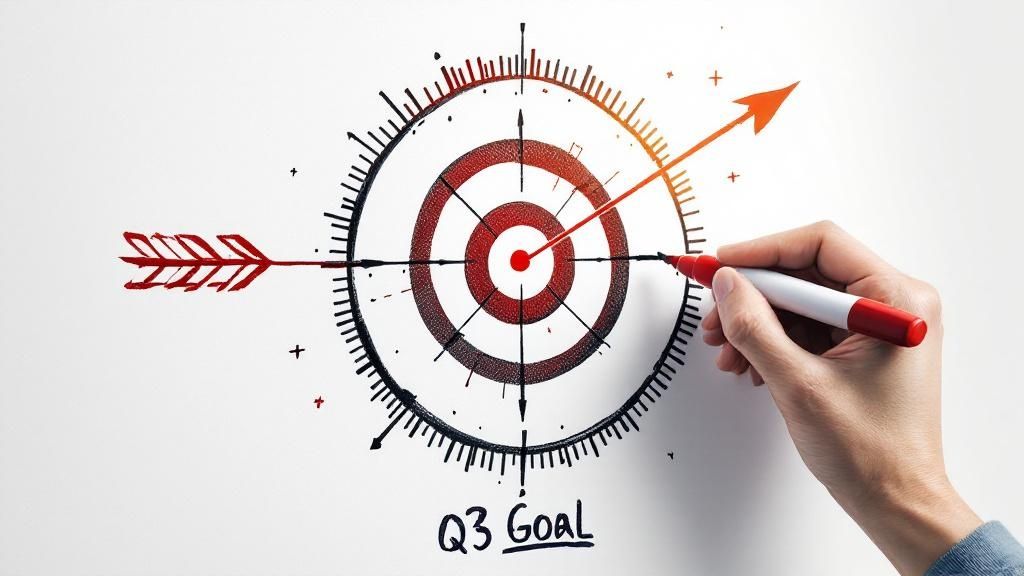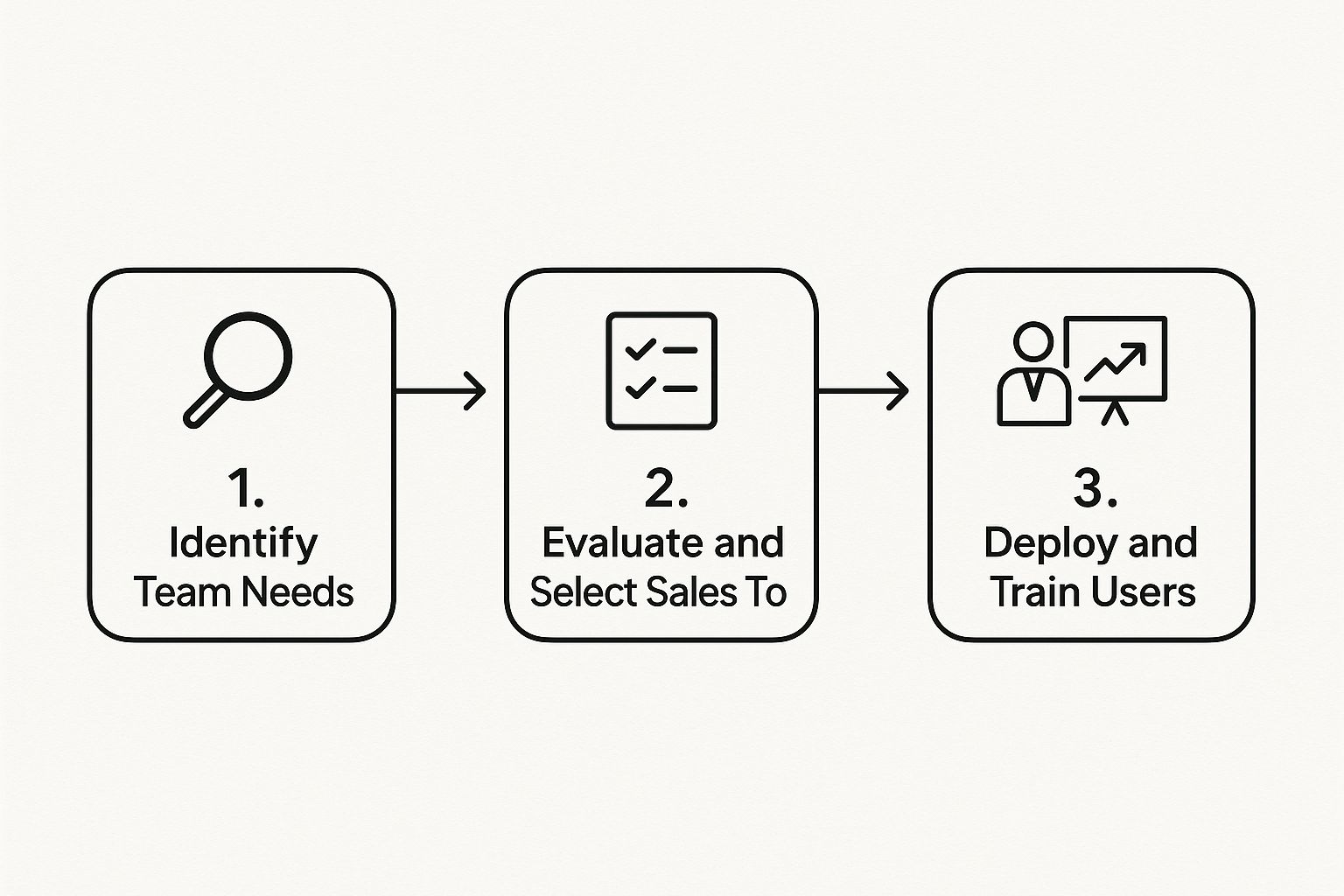Let's be honest. There isn't some secret formula for boosting your sales team's performance. The real key is a smart, strategic mix of crystal-clear goals, relentless skill-building, and the right technology. It’s all about ditching outdated tactics and building a modern, high-octane sales engine from the ground up.
Building the Foundation for Sales Excellence

Yesterday's sales playbook is officially obsolete. In a world full of savvy buyers and cutthroat competition, just telling your team to "sell harder" is a one-way ticket to burnout and missed targets. Real, lasting improvement demands a much more deliberate and structured approach. You have to build a foundation that supports every single rep, from the freshest hire to your most seasoned pro.
This isn't about wishful thinking. It's about constructing a solid framework with concrete pillars. Think of this as your roadmap—we're moving past the fluffy, generic advice to give you actionable strategies for building a team that doesn't just hit quotas but consistently blows them out of the water.
The numbers don't lie, and they paint a pretty grim picture. As of late 2024, sales teams globally only hit 43% of their assigned quotas on average by Q4. The B2B world is even tougher: only about 1% to 2% of leads ever convert into sales, and the average close rate is stuck around 20%. That means four out of every five potential deals in the pipeline simply fizzle out, which is a massive opportunity for anyone willing to do things differently.
The Core Pillars of Performance
To turn those numbers around, we need to get back to basics and focus on what actually drives success. Improving sales team performance isn't about finding one magic bullet. It’s about making strategic, interconnected improvements across a few critical areas. These pillars are the absolute bedrock of any high-functioning sales organization.
A huge part of this is creating effective support systems that give your reps the tools and resources they need to win. When they have what they need, they can finally focus on selling. You can find some fantastic sales enablement examples that show exactly how top-tier companies equip their teams for success.
A team's performance is a direct reflection of its underlying systems. Without a strong foundation—clear goals, effective processes, and the right tools—even the most talented individuals will struggle to reach their full potential.
Let's break down the essential components you need to nail.
- Clear Goal Setting: Go beyond a simple revenue target. Set specific, measurable, and relevant goals for both activities and skill development.
- Continuous Skill Development: Foster a culture where learning is a daily habit, not a once-a-year event. This means ongoing coaching and practical training.
- Optimized Sales Process: Define a repeatable, efficient workflow that zaps bottlenecks and gives reps a clear path from lead to close.
- Strategic Technology Adoption: Arm your team with tools that automate the grunt work and deliver actionable insights so they can win more deals.
To help visualize how these pieces fit together, I've put together a quick summary table.
Key Areas for Sales Performance Improvement
This table breaks down the core pillars for improving your team's effectiveness, showing where to focus and what you can expect from your efforts.
| Pillar | Primary Focus | Desired Outcome |
|---|---|---|
| Goal Setting | Defining clear, data-backed objectives for both individuals and the team. | Increased motivation, clear direction, and measurable progress toward targets. |
| Skill Development | Providing ongoing training, coaching, and resources to enhance rep capabilities. | Higher win rates, improved objection handling, and greater rep confidence. |
| Process Optimization | Streamlining the sales workflow to remove friction and improve efficiency. | Shorter sales cycles, fewer stalled deals, and a more predictable pipeline. |
| Technology Adoption | Implementing tools that automate tasks and empower reps with data. | More time spent selling, better personalization, and data-driven decision-making. |
When you treat these four areas as an interconnected system, you're not just hoping for better results—you're engineering them.
Foster a Culture of Continuous Sales Growth

Let's be honest: the days of the big, one-off, all-day training seminar are dead. Or at least, they should be. While they come from a good place, these expensive events usually lead to information overload, and most of what's "learned" is forgotten by the next quarter.
Real, lasting improvement in your sales team's performance doesn't come from a single event. It comes from weaving learning and development into the very fabric of their daily work. It needs to be a habit, not a dreaded annual obligation. This means shifting your mindset from periodic training to fostering a culture of continuous growth, creating an environment where reps are always sharpening their skills, sharing what works, and adapting on the fly.
Move Beyond Traditional Training Models
Instead of those marathon training sessions, think smaller. Breaking down complex topics into bite-sized, digestible pieces of content—often called micro-learning—is far more effective. It respects your reps' packed schedules and dramatically boosts how much they actually remember and apply.
Think about it. A new rep struggling to handle a specific objection doesn't need a four-hour lecture. They need a five-minute video they can pull up right before a call that shows them exactly how to counter it. Giving them on-demand access to relevant information is what truly moves the needle.
You can start building a library of these assets right away:
- Quick Video Tutorials: Short clips showing how to use a new CRM feature or walking through a tricky part of the sales process.
- One-Page Playbooks: Simple, scannable guides for handling common objections or tailoring a pitch to a specific buyer persona.
- Interactive Quizzes: Fast knowledge checks to reinforce key product details or sales methodology concepts.
This approach makes learning practical and immediately useful, closing the gap between knowing and doing.
The Power of Peer-to-Peer Learning
Some of the best training resources you have are sitting right in your sales pit. Your top performers are a goldmine of practical, field-tested knowledge. Your job is to create systems that let them share that expertise with everyone else.
Imagine a mid-level rep is struggling to get traction in a new vertical. Instead of just handing them a slide deck, pair them up with a senior rep who has a proven track record there. Let them shadow calls, review email sequences, and get direct, no-nonsense feedback.
The most powerful coaching often comes from people who are in the trenches every single day. Peer-led sessions build confidence, encourage collaboration, and ensure that best practices spread organically through the team.
This kind of collaborative learning turns individual wins into collective strengths. You can formalize this with weekly "film review" sessions, where the team breaks down recordings of discovery calls or demos. Analyzing what went right and what could be better not only sharpens skills but also builds a culture of transparency and shared success.
The numbers back this up. Companies that get serious about sales training see a 57% increase in sales effectiveness, on average. This commitment can drive a return on investment as high as 353% while also boosting win rates and keeping your best reps around longer. You can find more stats on the impact of sales training on hyperbound.ai.
Balance Foundational Skills with New Frontiers
A true culture of growth needs to do two things at once: reinforce the core skills and prepare the team for what's coming next. It's not enough to be good at the fundamentals; you also have to be ready for the future.
This means creating parallel learning tracks for your team.
Sharpening the Fundamentals:
- Active Listening
- Effective Questioning
- Articulating the Value Proposition
- Negotiation and Closing
Upskilling for New Frontiers:
- Social Selling on platforms like LinkedIn
- Using AI for prospect research
- Leveraging video in your outreach
- Mastering your B2B sales lead generation tools and techniques
By focusing on both foundational mastery and forward-looking skills, you build a team that's both consistent and innovative. This dual approach is the key to turning your sales organization into a dynamic, unstoppable engine for growth.
Designing a Sales Process for Peak Efficiency
Even the most talented reps will stumble if they're working within a broken or inefficient system. I’ve seen it happen time and time again. You can have a team of all-stars, but they’re not going to hit their numbers if the process itself is the bottleneck.
A high-performing team is built on the backbone of a streamlined, repeatable sales process. It’s the clear path from that first "hello" to a closed deal. Without it, reps waste precious time on admin, chase dead-end leads, and ultimately leave money on the table.
It’s no surprise that 91% of sales teams fail to hit quota expectations. We often blame the reps, but more often than not, the problem isn't the people—it's the system. Imagine a top rep who consistently gets buyers excited, only for every deal to stall because the pricing approval process is a bureaucratic nightmare. It looks like the rep can't close, but the real culprit is the workflow.
Auditing Your Current Workflow
Before you can fix your sales process, you have to understand where it's actually breaking down. This calls for an honest audit of your entire workflow, from the moment a lead enters your system to how a deal is marked "closed-won."
Start by mapping out every single step. Get granular. Then, look for the friction. Where do deals most often get stuck? Is it during discovery? The demo? Negotiation? A low lead-to-opportunity conversion rate, which should ideally be around 30%, often signals a problem with your initial qualification criteria.
Your goal is to find and stamp out these common bottlenecks:
- Slow Lead Response Times: If it takes hours—or worse, days—to follow up on an inbound lead, their interest is already gone. Poof.
- Vague Qualification Criteria: This is a classic time-waster. Reps end up with bloated pipelines full of prospects who were never going to buy in the first place.
- Fuzzy Handoffs: When the transition from an SDR to an AE is clunky, crucial information gets lost and hot leads fall right through the cracks.
- Content Chaos: Reps can spend nearly 40% of their week just searching for or creating their own content because they can't find what they need. That's two full days of lost selling time.
Tackling these issues head-on is the first real step toward building a more efficient sales engine. If you're ready to dig deeper, our guide on actionable steps for sales process optimization is a great place to start.
Adopting a Proven Methodology
Once you’ve cleared out the obvious clogs in the system, it's time to give your team a shared language and strategy. This is where a proven sales methodology like MEDDIC, Challenger Sale, or SPIN Selling becomes so valuable. It’s not just about rules; it’s about ensuring everyone approaches deals with the same strategic framework.
For instance, implementing MEDDIC (Metrics, Economic Buyer, Decision Criteria, Decision Process, Identify Pain, Champion) forces reps to qualify opportunities with real rigor. They can't just advance a deal because they had a "good conversation." They need concrete answers to critical questions.
A sales methodology isn't just a set of rules; it's a navigational chart that guides your team through complex deals, ensuring they focus on the activities that actually drive results and improve sales team performance.
This infographic shows a simple flow for implementing new tools or processes that support your team.

This kind of structured approach ensures that any new element, whether it’s a tool or a methodology, is chosen and rolled out with a clear purpose that directly helps your team win.
To truly take things to the next level, you need to look at the bigger picture. Learning the core principles of sales enablement is essential. A well-designed process supported by a strong enablement function creates a powerful one-two punch that translates directly into shorter sales cycles and higher win rates.
Using Technology to Empower Your Sales Team

Look, having a CRM is just table stakes these days. If that's the only real tech in your sales organization, you're already behind. To really move the needle on performance, you have to think beyond basic activity logging and start using technology that actually empowers your reps.
The right tools don't just organize data—they become a force multiplier for your team's talent. It's about shifting your mindset from just "adding software" to strategically building a tech stack that solves real problems. The best teams out there are using smart tools to cut out the grunt work, surface deep insights, and let sellers get back to what they actually do best: selling.
Move Beyond the Administrative Drag
One of the biggest silent killers of productivity is the time your reps burn on non-selling activities. It’s staggering when you look at the numbers. Some reports show that reps spend almost 28% of their week on administrative busywork. That's more than a full day, every single week, lost to data entry, scheduling, and internal updates.
This is exactly where sales engagement and automation platforms change the entire game. By taking those repetitive tasks off their plate, you're giving your team back their most valuable asset: time.
Think about the immediate impact of automating just a few key areas:
- Lead Nurturing: Set up automated email and social touchpoints to keep prospects engaged without a rep having to manually track every single follow-up.
- Data Entry: Find tools that automatically log calls, emails, and meetings directly into your CRM. This alone is a massive win.
- Scheduling: Get rid of the endless "what time works for you?" email chains. Automated calendar links let prospects book time instantly.
Giving a rep back even one extra hour a day to talk to prospects can have a huge effect on their pipeline and, frankly, their morale.
Arm Your Reps with Actionable Intelligence
In a competitive market, the team with the best information wins. Period. Modern sales intelligence tools go way beyond a simple contact list; they arm your reps with the context needed to have relevant, timely conversations.
This kind of tech can flag critical buying signals you’d otherwise miss—like when a target company gets a new round of funding, visits your pricing page, or posts a job description that perfectly matches your ideal user.
Technology should be a force multiplier for your team's talent. It’s not about replacing reps; it’s about making your good reps great and your great reps unstoppable by handling the manual work they hate.
Imagine your rep getting an alert that a key account they've been chasing just had three people browse your case studies. That's a powerful trigger for immediate, relevant outreach. This is how you transition from just making calls to making smart calls. A well-built tech stack makes sure this data flows right into the rep's workflow, making it impossible to ignore.
For instance, a modern outreach tool like Salesloop.io helps teams build and automate these kinds of personalized sequences, visualizing the entire campaign so nothing gets missed.

This kind of interface isn't just about automation; it's about giving time back to your team for the high-value conversations that actually close deals.
Ensure Your Tech Stack Works Together
Just buying a bunch of cool software isn't a strategy. It's a recipe for disaster. The biggest mistake I see leaders make is creating a patchwork of disconnected tools. This creates data silos, frustrates the heck out of your team, and ultimately hurts performance more than it helps.
For technology to be an asset, it needs to be integrated. Your core systems—CRM, sales engagement, and data sources—have to talk to each other seamlessly. If they don't, you're just forcing reps into manual workarounds, which completely defeats the purpose.
Finally, none of this matters if your team doesn't use the tools. Adoption is everything. If your reps don't understand why you chose a tool or how it helps them hit their number, it will become shelfware. Every new tech rollout needs to come with solid training that answers the "what's in it for me?" question for the seller. Show them how it directly impacts their commission check, and you'll get the enthusiastic adoption you're looking for.
Mastering Data-Driven Coaching and Motivation
Let's be honest. Truly effective sales management isn't about staring at pipeline reports or hounding reps about their numbers. That’s supervision, not leadership. The real magic happens when you start coaching—when managers transform from supervisors into performance multipliers who can unlock the potential of every single person on their team.
To get there, you have to move beyond just tracking output metrics and start digging into the how behind the what. This means using qualitative data to give personalized, impactful feedback that actually helps people get better at their jobs.
Shifting from Reviewer to Developer
Think about the typical one-on-one. Too often, it’s a historical review of what’s already happened. "Why did this deal stall?" "What's the story with that lead?" While you do need those updates, a backward-looking approach does very little to build skills for the future.
Instead, you need to reframe these meetings as forward-looking, developmental sessions. The goal isn't to critique past fumbles but to build future wins. This is where qualitative data, especially from call recordings, becomes your most powerful tool.
Listening to a rep's actual calls lets you move past the numbers on a spreadsheet. You can pinpoint the exact moment a conversation went sideways or celebrate a perfectly executed discovery question. This creates opportunities for incredibly specific, actionable coaching that sticks.
A manager's job isn't to have all the answers. It's to ask the right questions that help reps discover the answers for themselves. This builds a team of proactive problem-solvers, not just order-takers.
Use coaching prompts that encourage your reps to think for themselves. It’s far more effective than just telling them what to do.
-
Instead of: "You should have asked about their budget sooner."
-
Try: "Thinking back on the call, where do you think would have been a good moment to explore their budget?"
-
Instead of: "You didn't create enough urgency."
-
Try: "What's one thing you could try on the next call to better connect our solution to their timeline?"
This Socratic approach empowers reps to own their development, which makes the lessons far more memorable.
Motivation Beyond the Commission Check
While compensation is obviously important, it's rarely the only thing that drives top performers. Real, sustainable motivation comes from a sense of purpose, growth, and recognition. In fact, research shows that continuous coaching alone can lead to 32% higher win rates and 28% higher quota attainment.
If you want a genuinely motivated team, you need to tap into those deeper drivers.
Meaningful Recognition
Celebrating wins is crucial, but get specific. A generic "great job" is forgettable. Instead, highlight the exact skill that led to the win. For example, "The way you uncovered that hidden pain point during discovery was textbook. That's what sealed this deal." This reinforces the right behaviors for the whole team to see.
Healthy Competition
Leaderboards can be a great tool, but don't just focus on closed revenue. That can demoralize reps who are doing all the right things but have longer deal cycles. Track a mix of leading indicators to give everyone a chance to shine.
| Leaderboard Type | Metric to Track | Why It's Effective |
|---|---|---|
| Activity Board | Dials, New Conversations Started | Rewards consistent effort, which is great for building habits, especially for new reps. |
| Pipeline Board | New Opportunities Created, Demos Set | Highlights reps who are fantastic at top-of-funnel activities and building a healthy pipeline. |
| Conversion Board | Win Rate, Lead-to-Opportunity % | Celebrates efficiency and skill, recognizing those who are masters at moving deals forward. |
Connecting to the Vision
Your reps need to see how their daily grind contributes to the bigger picture. Regularly share company milestones and successes, and be explicit about how the sales team's hard work made them possible. When a rep understands their direct impact on the company's journey, their work takes on a whole new level of meaning.
For a deeper look at equipping your team with the right resources, check out our guide on the top sales enablement strategies that align individual efforts with company goals.
Even with the best strategies humming along, you're always going to have questions. Sales is a living, breathing thing—what crushed it last quarter might need a tune-up this quarter. This is where we tackle the nitty-gritty questions that pop up for sales leaders trying to build a high-achieving team.
Forget the high-level theory. This is your field guide for those nagging challenges that stand between your team and its true potential. Let's get straight to the answers for the problems you're probably wrestling with right now.
How Can We Improve Performance Without Burning Out the Team?
This is the million-dollar question, isn't it? The goal is to boost efficiency, not just activity. Simply demanding more dials and emails without a smarter system is a one-way ticket to burnout city. The real win is in working smarter, not just harder.
The biggest thief of a sales rep's time is almost always administrative drag. It's shocking, but reps can spend up to 28% of their week on tasks that have nothing to do with selling. Getting that time back is your single biggest opportunity.
- Automate the Annoying Stuff: Bring in tools that handle the mind-numbing work. Think data entry, scheduling follow-ups, and logging activities in the CRM. Every single hour you save them is another hour they can spend having real conversations with prospects.
- Fix Your Broken Processes: A clunky sales process—one with too many approval steps or confusing handoffs—creates a massive amount of friction. Map it out and cut the fat. Make it dead simple for your reps to move a deal from one stage to the next.
- Focus on What Moves the Needle: Coach your team to be ruthless with their priorities. That means less time chasing low-potential leads and more time nurturing the opportunities that are actually qualified to buy.
When you clear the path by removing obstacles and automating low-value work, you're not just asking them to do more. You're empowering them to achieve more in the same amount of time, which skyrockets both performance and morale.
What Are the Most Important Sales Metrics to Track?
Every business has its own quirks, but a handful of core metrics will give you a crystal-clear window into your sales team's health. It's easy to get lost in a sea of data, so avoid "analysis paralysis" by zeroing in on the numbers that actually tell a story.
The metrics you track will dictate your team's behavior. If you only track closed revenue, you're missing all the leading indicators that create that revenue. A balanced approach gives you the full picture.
Here’s a no-nonsense breakdown of where to focus your attention:
| Category | Key Metrics to Track | What It Tells You |
|---|---|---|
| Activity | Calls Made, Emails Sent, Demos Booked | The raw effort and hustle your team is putting in. |
| Pipeline | New Opportunities Created, Pipeline Coverage | The health and volume of your future business. |
| Efficiency | Win Rate, Sales Cycle Length, Avg. Deal Size | How effectively your team turns effort into money. |
| Outcomes | Quota Attainment, Total Revenue | The bottom-line results of all your sales efforts. |
By tracking a mix of these, you can spot problems before they blow up. For instance, if activity is high but your win rate is tanking, it's a huge red flag that you need to jump in with some coaching on qualification or objection handling.
How Long Should It Take for a New Sales Rep to Be Productive?
There's no single magic number here. It really depends on how complex your product is, how long your sales cycle runs, and—most importantly—how good your onboarding is. That said, a solid rule of thumb is to expect a new rep to be fully ramped and hitting their stride within three to six months.
A well-designed onboarding plan is your secret weapon for shrinking that ramp-up time. Please don't be the manager who just hands a new hire a laptop and a phone list.
A killer onboarding program has to include:
- Product and Market Immersion: Deep dives into what you sell, who you sell it to, and the specific problems you solve for them.
- Process and Systems Training: Hands-on walkthroughs of the CRM, sales engagement platform, and any other tools they'll live in every day.
- Sales Skill Development: Coaching on your specific sales methodology, from how you prospect to how you close.
- Shadowing and Mentorship: Pairing new reps with your top performers so they can see what "good" looks like in action.
Great onboarding isn't an expense; it's an investment that pays you back over and over in speed-to-productivity and long-term retention. It’s one of the most direct levers you can pull to improve team performance from day one.
What’s the Best Way to Motivate a Sales Team Besides Money?
Commission checks are obviously a huge driver, but they can't be the only one. The best teams I've ever seen are fueled by a culture of growth, recognition, and a real sense of purpose.
- Meaningful Recognition: Go way beyond a generic "good job" in the team chat. Publicly celebrate specific wins, and more importantly, call out the behaviors that led to that win. This shows the whole team what excellence actually looks like.
- Career Development: Show your reps you're invested in them as people, not just as numbers on a board. Give them a clear path for growth in the company and invest in their skills with ongoing coaching and training.
- Healthy Competition: Leaderboards are great, but don't just track revenue. Celebrate the leaders in activities like new opportunities created or meetings booked. This gives everyone, not just the top closers, a chance to shine and be recognized for their hard work.
- A Sense of Purpose: Constantly connect the team's daily grind to the company's big-picture mission. Help them see how their work directly impacts your customers and the business.
These intrinsic motivators build a powerful, sustainable fire that money alone can never buy.
Ready to stop talking and start doing? To put these strategies into action, you need to arm your team with tools that clear the way for them to succeed. Salesloop.io automates the tedious parts of outreach so your reps can focus on what they do best—building relationships and closing deals.
Take control of your pipeline and start improving your team’s performance today.





